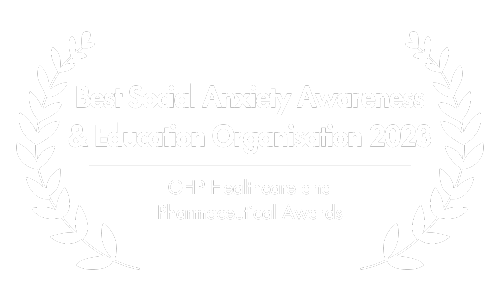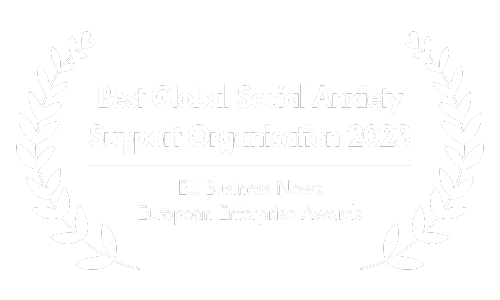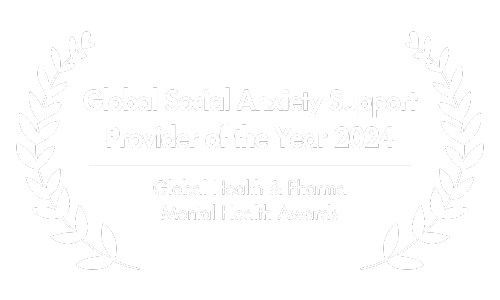Exposure Therapy for Social Anxiety: A Practical Guide to Lasting Change
This article includes recommendations for a virtual reality software, a book & an online therapy provider that help with social anxiety. If you purchase product services through our links, you may receive a significant discount and we will receive a commission.
Social anxiety disorder is a debilitating condition that affects millions of people worldwide.
It’s not just about feeling shy or nervous in social situations; it’s a persistent fear that can make everyday interactions feel overwhelming and isolating.

If you’re struggling with social anxiety, you’re not alone, and there is hope for improvement. One of the most effective treatments for social anxiety is exposure therapy.
This article aims to demystify this powerful approach, explaining what it is, how it works, and how it can help you regain control over your life.
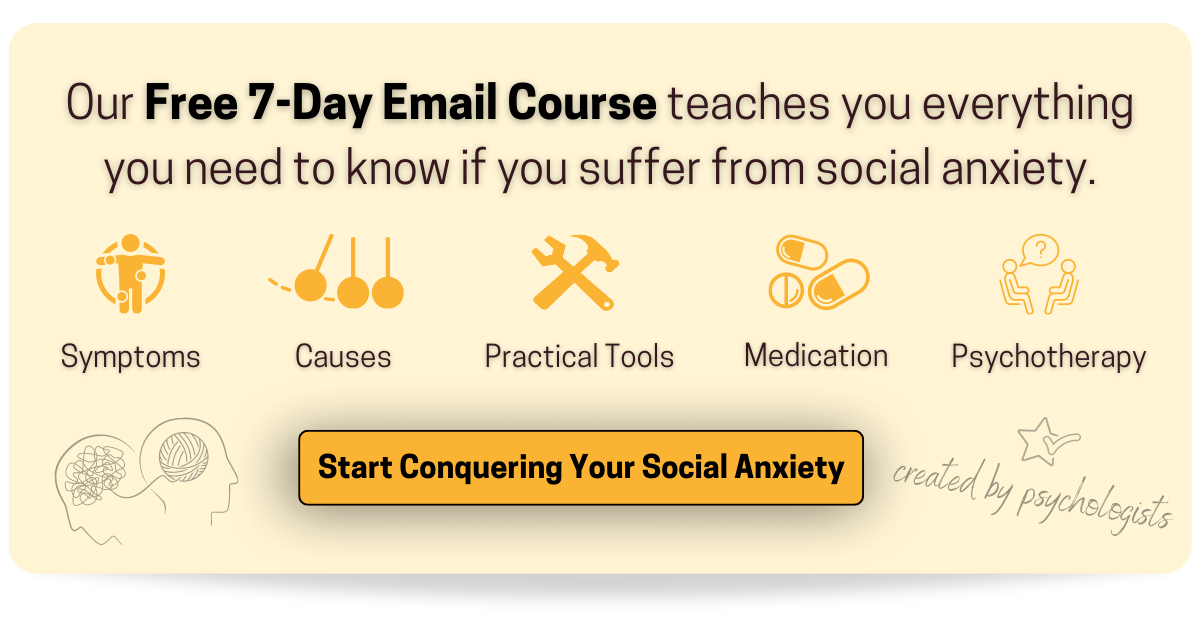
A. What is Exposure Therapy?
Exposure therapy is a form of Cognitive Behavioral Therapy (CBT) specifically designed to help people confront and reduce their fear or anxiety.
The core idea is simple yet powerful: by gradually and systematically facing the situations you fear, you can learn to cope with them more effectively.
Imagine you’re afraid of speaking in public, a common fear among those with social anxiety.
In exposure therapy, you would start by identifying this fear and then work with a trained therapist to gradually expose yourself to speaking situations.

You might begin with something less intimidating, like speaking to a small group of friends, before progressing to more challenging scenarios, such as giving a presentation at work.
The goal is not to eliminate the fear entirely but to reduce it and manage it better, so it no longer controls your life.
By repeatedly facing the situations that make you anxious, you’re essentially “retraining” your brain to react differently to these scenarios.
B. How Does Exposure Therapy Work?
The effectiveness of exposure therapy is rooted in psychological principles, specifically the concepts of “fear extinction” and “habituation.”
In simple terms, fear extinction is the process by which repeated exposure to a feared situation reduces the emotional response to it over time.
This is similar to the Pavlovian extinction model, where conditioned responses can be unlearned through repeated exposure without reinforcement.

Habituation, on the other hand, refers to the process where an individual becomes accustomed to a stimulus or situation through repeated exposure, leading to a decrease in their anxiety or fear response.
Essentially, the more you’re exposed to something you fear, the less fearful it becomes, as your brain starts to recognize it as non-threatening.
In the context of social anxiety, let’s say you’re terrified of attending social gatherings. Each time you go to one, your brain triggers a fear response, making you want to avoid such situations.
However, when you engage in exposure therapy, you intentionally put yourself in these social settings under controlled conditions.
Over time, through habituation and fear extinction, your brain learns that these situations are not as threatening as once believed, thereby reducing your anxiety.

It’s important to note that exposure therapy is most effective when done gradually and systematically.
This involves beginning with situations that are less anxiety-provoking and progressively moving to more challenging ones, as illustrated in the graphic below.
This graphic represents an example of an ‘exposure hierarchy‘, a personalized ladder of situations that range from easier to more difficult, tailored to the individual’s unique fears and comfort levels.
The aim is to build your confidence and coping skills step by step, making it easier to manage your social anxiety in various contexts.
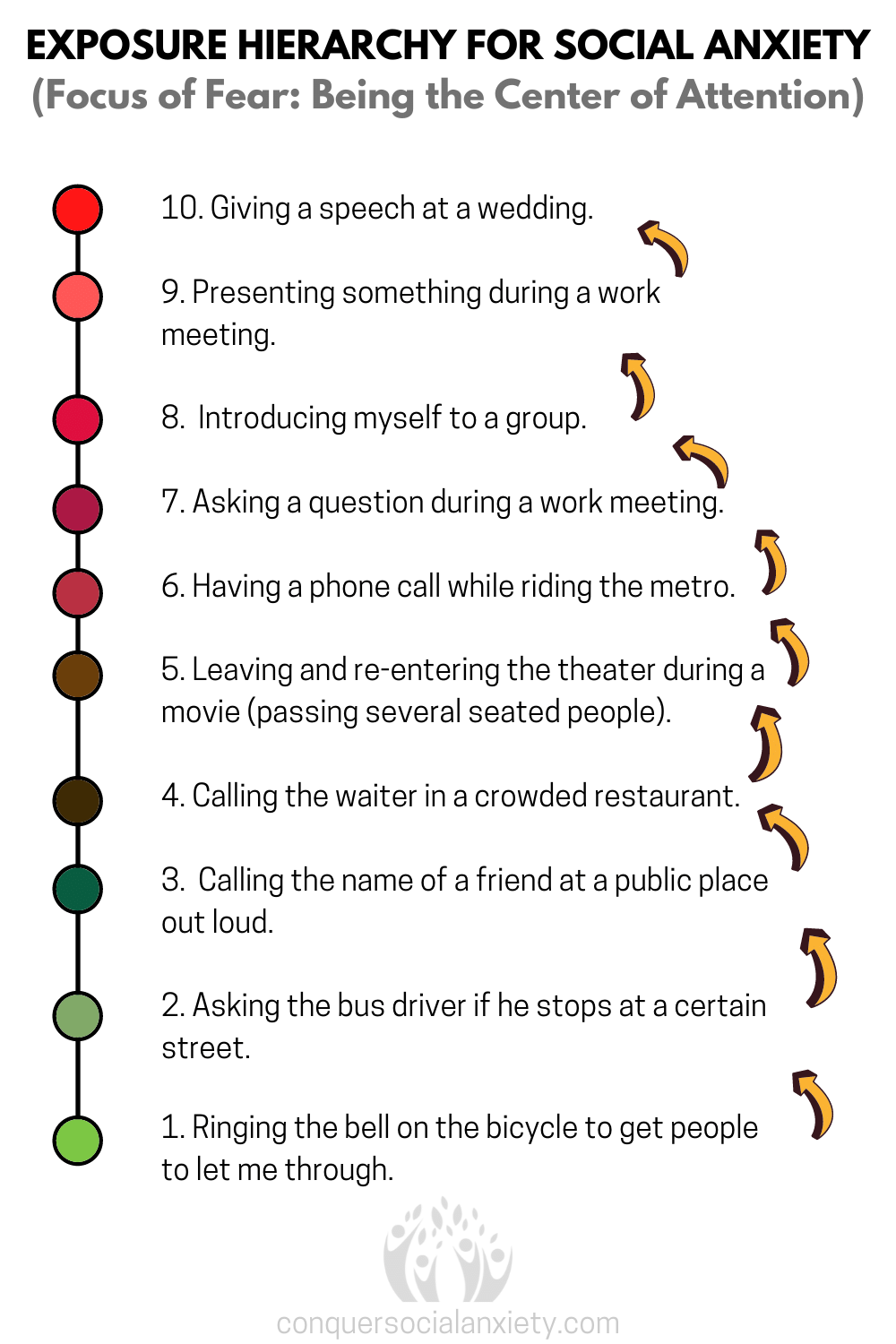
Creating a hierarchy of exposure is usually part of standard cognitive behavioral therapy interventions for social anxiety. To find out more about CBT, you can click here to read our in-depth article.
C. Effectiveness of Exposure Therapy for Social Anxiety
If you’re dealing with social anxiety, you’ll be pleased to know that exposure therapy is not just a theoretical concept; it’s a treatment backed by substantial scientific evidence.

In fact, it’s one of the fastest ways to regain control over your life. Here are some key studies that attest to its effectiveness:
- General Effectiveness: A study by Kaczkurkin and Foa (2015) found that exposure therapy, whether used alone or integrated with other cognitive therapies, significantly reduces symptoms of social anxiety.
- Long-Term Benefits: Research by Anderson et al. (2017) indicates that the benefits of exposure therapy, including virtual reality exposure, can be long-lasting, leading to sustained improvements in well-being and task performance.
- Virtual Reality: Studies have shown that virtual reality exposure therapy is as effective as traditional methods in treating social anxiety (Chesham et al., 2018).
- Adaptability Across Ages: Exposure therapy has been effectively adapted for adolescents, particularly when merged with social skills training in a school-based initiative (Masia Warner et al., 2007).
- Specific Techniques: Some newer techniques, like “social mishap exposure practice,” have been developed to target specific aspects of social anxiety, leading to significant improvements in treatment gains (Fang et al., 2014). You can click here to read our article addressing these exercises.
This wealth of research not only attests to the effectiveness of exposure therapy but also highlights its versatility and adaptability, making it a compelling option for those struggling with social anxiety.

D. Virtual Reality as an Emerging Tool
In recent years, technology has opened up new avenues for treating social anxiety, and one of the most promising developments is Virtual Reality Exposure Therapy (VRET).
This innovative approach uses virtual reality to simulate social situations that might trigger anxiety, allowing you to practice coping strategies in a safe and controlled environment.
What makes VRET particularly compelling is that it has been found to be as effective as traditional exposure methods.
In a study by Chesham et al. (2018) virtual reality exposure therapy showed significant overall effect sizes, indicating its effectiveness in reducing social anxiety.

This means you don’t necessarily have to confront real-world situations right away; you can start by practicing in a virtual setting and then transition to real-life scenarios as you become more comfortable.
The use of virtual reality expands the horizons of exposure therapy, making it more accessible and less intimidating for those who might be hesitant to try traditional methods.
Recommendation: VirtualSpeech
One leading platform that utilizes VR for exposure to anxiety-inducing social situations is VirtualSpeech.
VirtualSpeech offers a wide range of exercises designed to improve public speaking, interpersonal communication, and assertiveness, making it a great resource for those dealing with social anxiety.
Note: While using a VR headset is the ideal way to experience VirtualSpeech, the platform can also be accessed directly through your web browser.
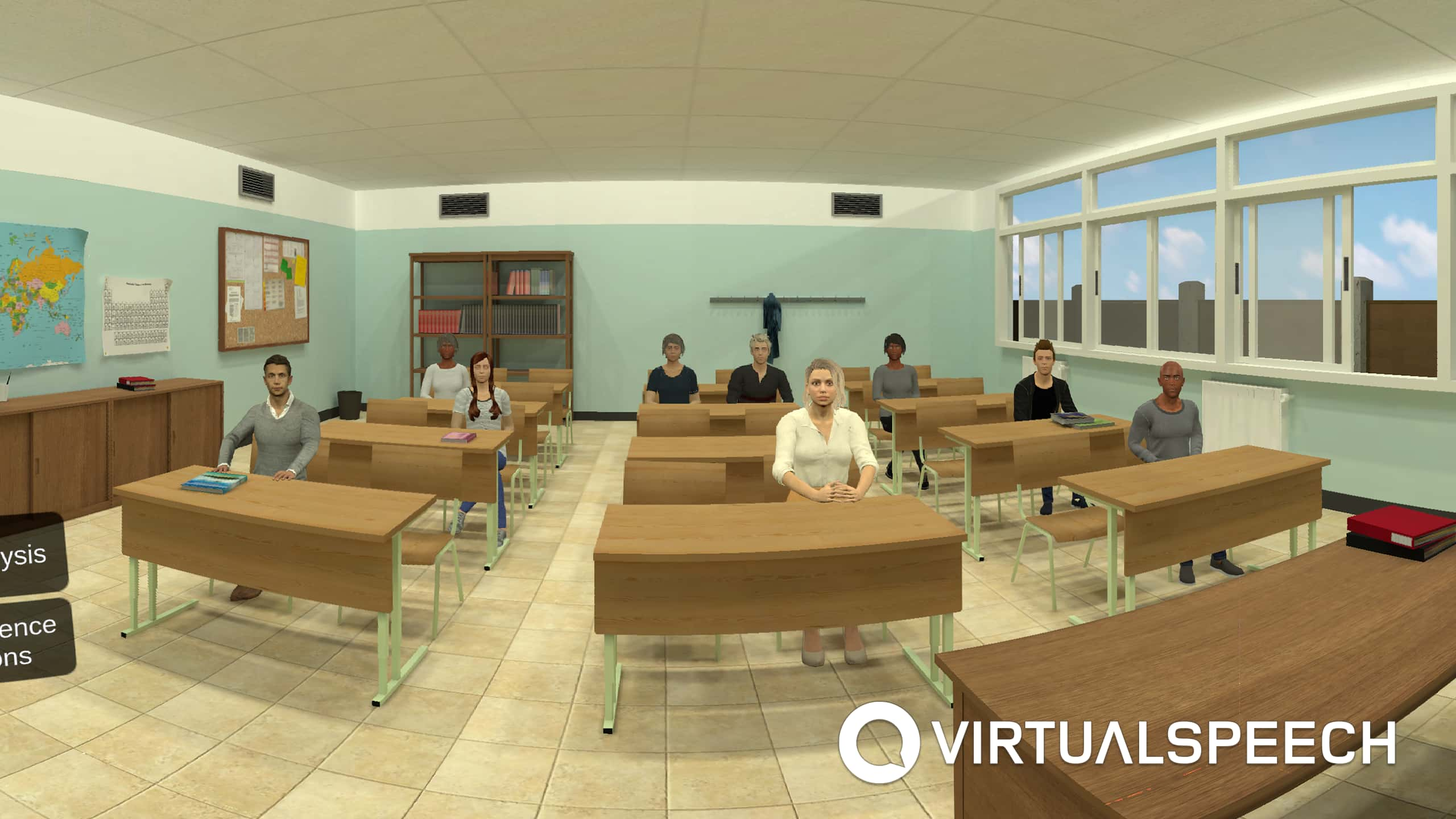
How VirtualSpeech Can Help:
- Safe Environment: VirtualSpeech provides a virtual reality setting that allows users to practice social interactions in a low-stakes, safe environment, reducing the immediate social risks and consequences.
- Realistic Scenarios: The platform offers a variety of scenarios that someone with social anxiety might find challenging, such as speaking in front of a group, attending a networking event, or going through a job interview.
- Immediate Feedback: One of the standout features of VirtualSpeech is its ability to provide real-time feedback on various aspects of your performance, such as eye contact, volume, and filler words. This allows you to make instant improvements.
- Skill Building: By repeatedly practicing in these virtual scenarios, you can build the skills and confidence needed to navigate similar situations in the real world.
- Accessibility: VirtualSpeech is generally compatible with popular VR headsets, making it relatively easy for people to access and use the platform from the comfort of their own homes. However, they also offer interactive exercises that can be completed in your browser, without the need for a VR headset.
- Supplement to Traditional Therapy: While VirtualSpeech is not a replacement for professional treatment, it can serve as a valuable supplement to traditional exposure therapy methods for social anxiety.
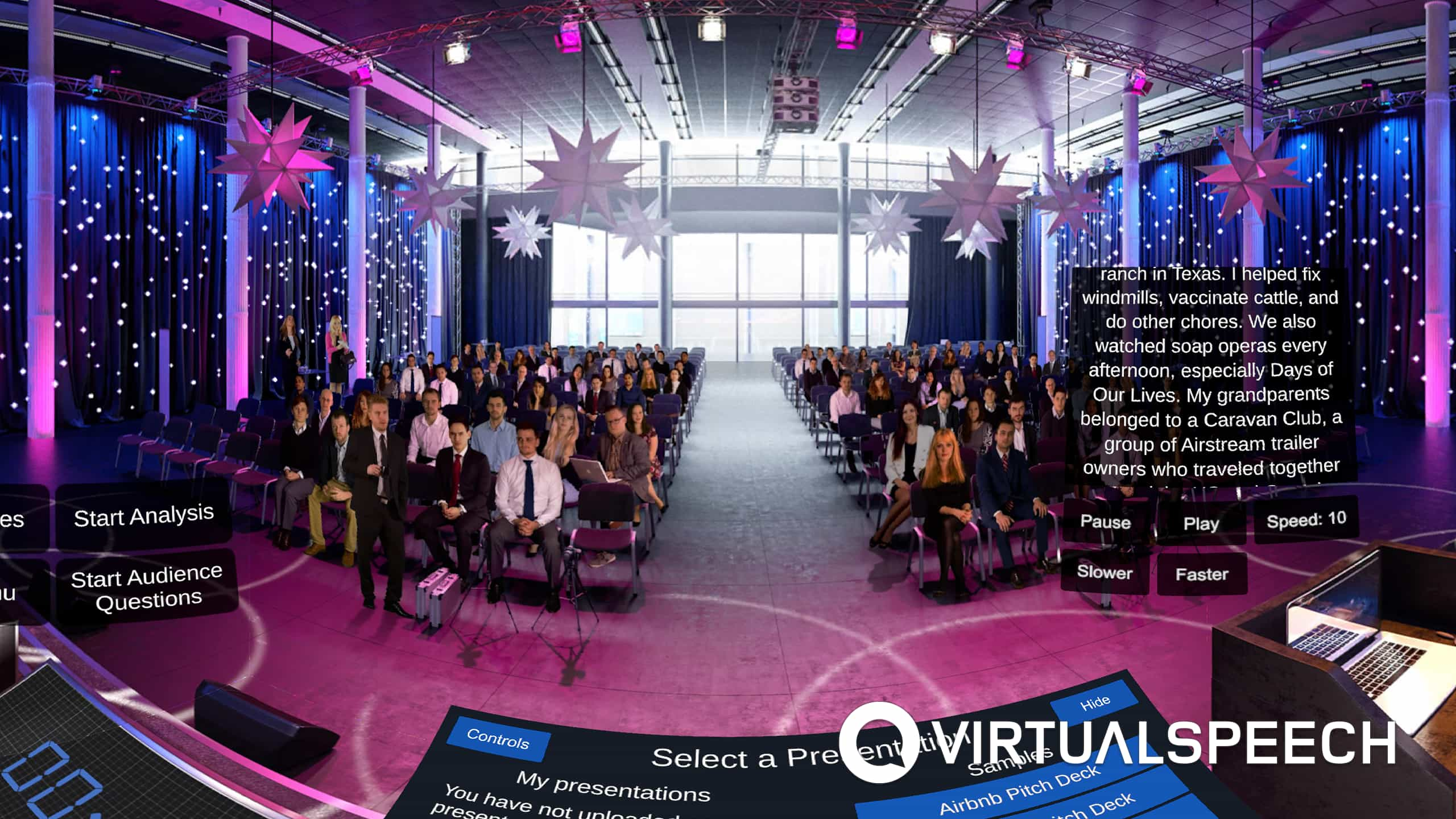
VirtualSpeech offers a plethora of exercises that cater to various aspects of social anxiety.
While the platform is often associated with business scenarios, its exercises can be adapted for general social situations. Here’s a breakdown of the main categories and the exercises under each:
1. Giving a Speech or Presentation Skills:
- Presentation Skills Practice: Deliver presentations in different settings and receive AI feedback.
- Learning a Speech: Break down and practice your speech, focusing on main and sub-points.
- Impromptu Speech Training: Enhance your ability to think on your feet by discussing random images.
- Lecture Hall: Practice delivering speeches in a large lecture setting, with slide loading and speech analysis features.
2. Interpersonal Skills:
- Roleplay with ChatGPT: Engage in various simulated conversations, from sales pitches to challenging personal interactions.
- Debating Skills: Engage in debates with AI avatars, either one-on-one or in a moderated setting.
- Active Listening Exercises: Improve your listening skills with exercises like the Goldilocks method and simulated conference calls.
- Meeting Presence: Lead meetings, present, and respond to questions from virtual avatars.

3. Assertiveness Skills:
- Saying ‘No’: Practice assertively declining requests using techniques from psychologist Trevor Powell.
- Media Ambush: Handle unexpected media confrontations in settings like a hotel lobby.
- Press Conference: Present your statements or materials in a simulated press conference.
4. Media Interaction Skills:
- Media Scenarios Tour: Navigate various media situations, from TV interviews to press conferences.
- Radio or Podcast Interview: Practice being interviewed for radio or podcasts, with feedback.
- TV Interview: Handle interview questions in a TV studio setting, focusing on staying composed under pressure.
By immersing yourself in these virtual scenarios repeatedly, your brain undergoes the processes of fear extinction and habituation, the foundational principles of exposure therapy we highlighted earlier.
To explore VirtualSpeech and see how it can supplement your exposure therapy, simply click below.
Also, if you’re considering a more immersive experience with a VR headset instead of using VirtualSpeech through your browser, the Meta Quest is currently the most cost-effective compatible option.
You will be able to download the VirtualSpeech app directly to your headset. You can find the Meta Quest here.
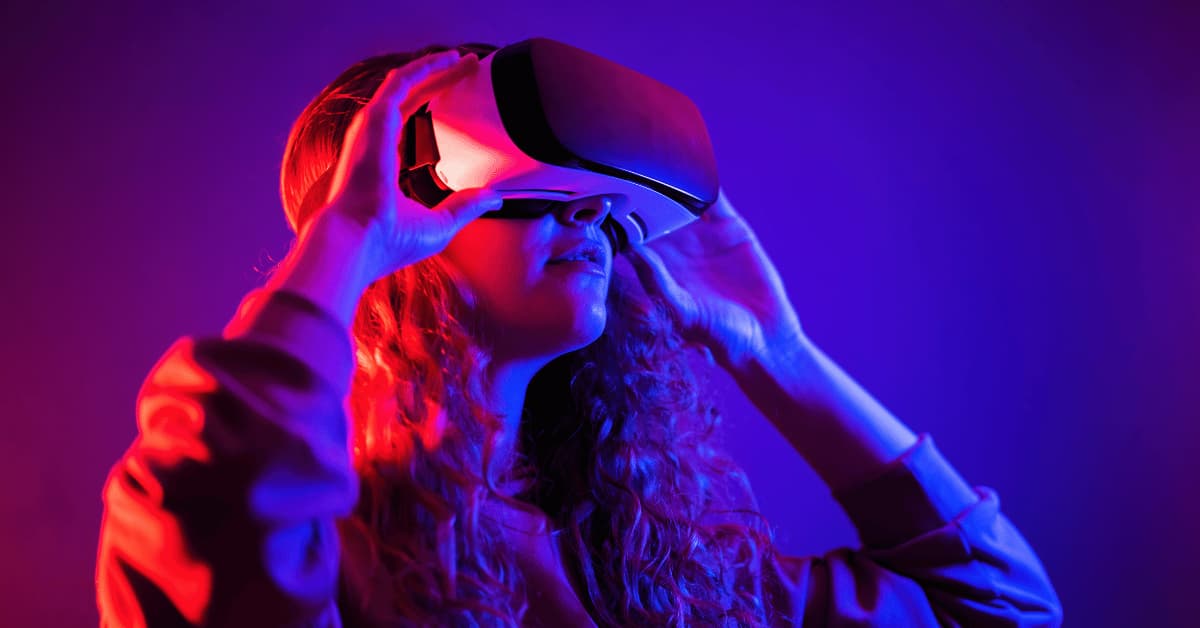
E. Longevity of Treatment Gains
One of the most encouraging aspects of exposure therapy is that the benefits often extend well beyond the treatment period.
This isn’t a quick fix that fades away; it’s a methodical approach that can lead to lasting changes in how you handle social situations.
A study by Anderson et al. (2017) found that both traditional exposure therapy and its virtual reality counterpart led to sustained improvements in well-being and task performance.

What does this mean for you?
It means that the hard work you put into exposure therapy has the potential to pay off in the long run.
You’re not just learning to cope with social anxiety for a day or a week; you’re acquiring skills and strategies that can help you manage your anxiety effectively for years to come.
F. Adaptability Across Age Groups
Social anxiety doesn’t discriminate by age; it can affect anyone from teenagers to adults. The good news is that exposure therapy is versatile enough to be adapted for different age groups.

For instance, a study by Masia Warner et al. (2007) found that a school-based initiative that combined social skills training with exposure techniques significantly reduced social anxiety among adolescents.
(By the way, you can click here if you want to learn more about social skills training for social anxiety).
This adaptability makes exposure therapy a compelling option for people of all ages.
Whether you’re a teenager who dreads speaking in class or an adult anxious about workplace interactions, exposure therapy can be tailored to meet your specific needs.
The key is to work with a trained therapist who can help you identify your triggers and develop a personalized treatment plan.

G. Practical Tips for Implementing Exposure Therapy
If you’re considering exposure therapy for social anxiety, here are some practical tips to help you get started:
- Consult a Trained Therapist: The first step is to consult with a healthcare provider or a trained therapist who specializes in treating social anxiety. They can help you develop a personalized treatment plan.
- Create an Exposure Hierarchy: Work with your therapist to create an “exposure hierarchy,” a list of situations that trigger your social anxiety, ranked from least to most anxiety-provoking. This will serve as your roadmap for treatment.
- Start Small: Begin with the least anxiety-provoking situations on your exposure hierarchy and gradually work your way up to more challenging scenarios. This helps build your confidence and coping skills.
- Be Consistent: Consistency is key. Make a commitment to regularly practice exposure exercises, whether it’s once a week or more often.
- Track Your Progress: Keep a journal or use an app to track your experiences, thoughts, and feelings during exposure exercises. This can provide valuable insights and help you measure your progress.
- Use Technology: Consider supplementing your treatment with virtual reality exposure therapy. Apps like VirtualSpeech offer a safe and controlled environment for practicing social situations (Note: Consult your healthcare provider for personalized guidance).
- Celebrate Small Wins: Every step forward is a victory. Celebrate your progress, no matter how small, to keep yourself motivated.
- Seek Support: Don’t underestimate the power of a strong support network. Share your journey with trusted friends or family members who can offer encouragement and accountability.
By following these tips and working closely with a trained therapist, you can make significant strides in managing your social anxiety and improving your quality of life.
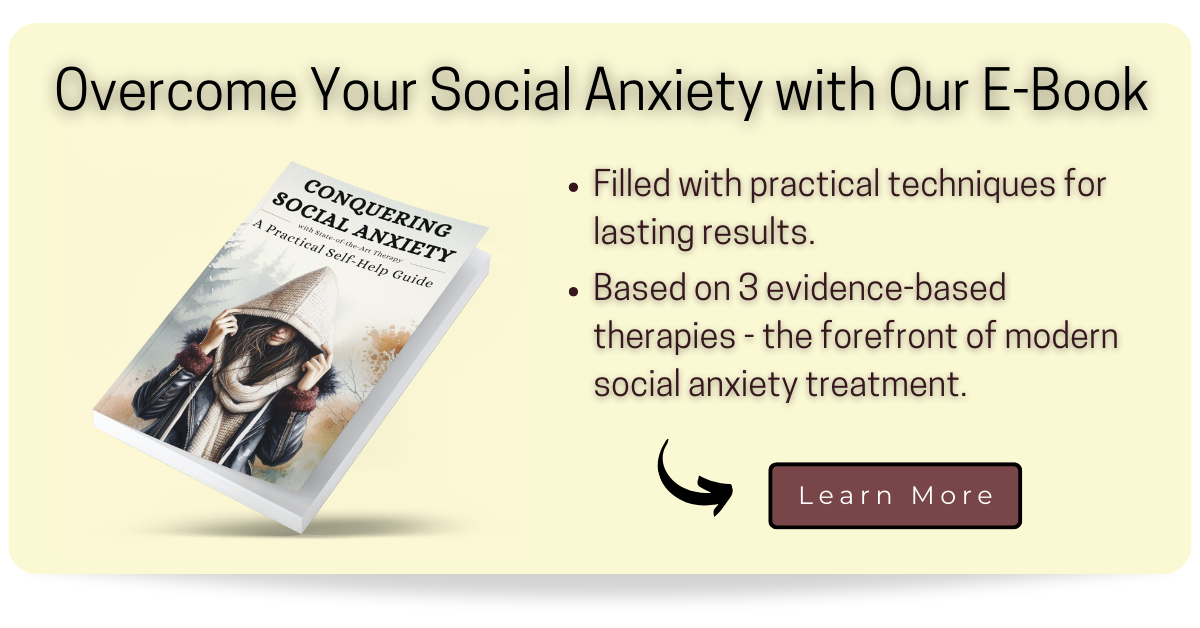
H. Recommended Further Resources
Workbook for Self-Guided Exercises
If you’re looking for a structured way to manage your social anxiety, consider checking out “The Shyness and Social Anxiety Workbook“. This resource offers practical exercises and strategies that can complement your exposure therapy exercises. You can purchase the workbook here.

Tailored Online Therapy Experience
In partnership with Online-Therapy, we’re pleased to recommend a comprehensive therapy package tailored to your needs. This includes:
- One live session per week (choose from video, voice, or text)
- Unlimited messaging with your therapist
- An 8-section CBT program featuring 25 worksheets
- Daily worksheet feedback
- Additional resources like yoga and meditation videos, a journal, activity plan, and self-assessment tests
The platform allows you to easily switch therapists to find the right fit, all within a secure and confidential environment.
To get started, register for ‘individual therapy‘ and select ‘social anxiety‘ as your focus. You can then provide more details about your specific situation.
Their plans start at just $40 per week. You can use the following link to sign up, which will grant you a 20% discount for your first month of therapy.

I. Conclusion
Social anxiety can be a debilitating condition, but it doesn’t have to define you. Exposure therapy offers a proven, effective way to confront and manage your fears.
From traditional methods to innovative approaches like virtual reality, exposure therapy is adaptable and can be tailored to meet your specific needs.
Whether you’re a teenager anxious about school or an adult navigating the complexities of the workplace, this treatment offers a path to a more confident and fulfilling life.
Remember, the journey may be challenging, but you don’t have to go it alone. Consult with a trained therapist, create an exposure hierarchy, and take it one step at a time.
With consistency and the right support, you can make meaningful progress in managing your social anxiety.

If you’re eager to embark on a journey of exploration through diverse therapeutic avenues to address social anxiety, we invite you to discover our complete therapy guide by clicking right here.
Furthermore, if you’re seeking a comprehensive overview that spans therapy, medication, and self-help approaches, you’re welcome to dive into our in-depth guide available here.
In addition, we have created a comprehensive guide to pharmacotherapy for social phobia. If you are interested in medication approaches, just click here.
Still have lingering questions? Take a step toward clarity and empowerment by enrolling in our Free 7-day Email Course. We’re dedicated to being your guide on this journey of understanding and growth.

Anderson, P. L., Edwards, S. M., & Goodnight, J. R. (2017). Virtual Reality and Exposure Group Therapy for Social Anxiety Disorder: Results from a 4–6 Year Follow-Up. Cognitive Therapy and Research, 41(2), 230–236. https://doi.org/10.1007/s10608-016-9820-y
Chesham, R. K., Malouff, J. M., & Schutte, N. S. (2018). Meta-analysis of the efficacy of virtual reality exposure therapy for social anxiety. Behaviour Change, 35(3), 152–166. https://doi.org/10.1017/bec.2018.15
Fang, A., Sawyer, A. T., Asnaani, A., & Hofmann, S. (2013). Social Mishap Exposures for Social Anxiety Disorder: An Important Treatment Ingredient. Cognitive and behavioral practice, 20(2), 213–220. https://doi.org/10.1016/j.cbpra.2012.05.003
Kaczkurkin, A. N., & Foa, E. B. (2015). Cognitive-behavioral therapy for anxiety disorders: an update on the empirical evidence. Dialogues in clinical neuroscience, 17(3), 337–346. https://doi.org/10.31887/DCNS.2015.17.3/akaczkurkin
Masia Warner, C., Fisher, P. H., Shrout, P. E., Rathor, S., & Klein, R. G. (2007). Treating adolescents with social anxiety disorder in school: an attention control trial. Journal of child psychology and psychiatry, and allied disciplines, 48(7), 676–686. https://doi.org/10.1111/j.1469-7610.2007.01737.x
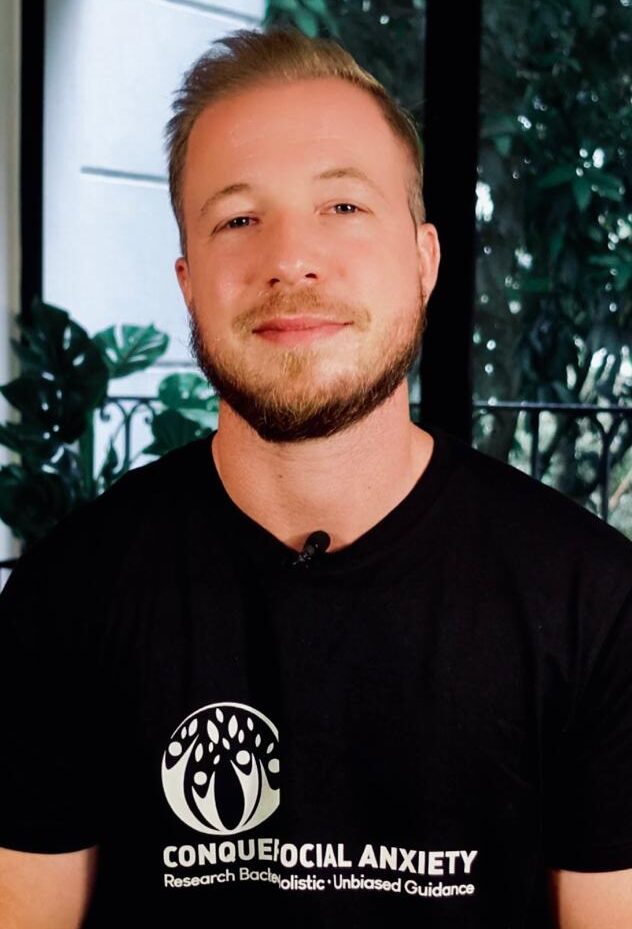
About the Author: Martin Stork
Martin is a professional psychologist with a background in physical therapy. He has organized and led various support groups for people with social anxiety in Washington, DC and Buenos Aires, Argentina. He is the founder of Conquer Social Anxiety Ltd, where he operates as a writer, therapist and director. You can click here to find out more about Martin.







